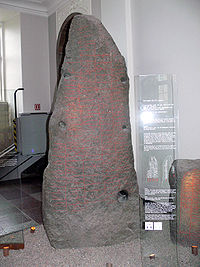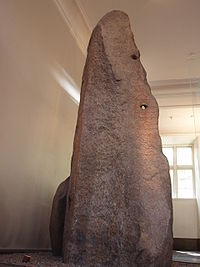
Tryggevælde Runestone
Encyclopedia


Rundata
The Scandinavian Runic-text Data Base is a project involving the creation and maintenance of a database of runic inscriptions. The project's goal is to comprehensively catalog runestones in a machine-readable way for future research...
, is a runestone housed in the National Museum of Denmark
National Museum of Denmark
The National Museum of Denmark in Copenhagen is Denmark’s largest museum of cultural history, comprising the histories of Danish and foreign cultures, alike. The museum's main domicile is located a short distance from Strøget at the center of Copenhagen. It contains exhibits from around the world,...
, in Copenhagen
Copenhagen
Copenhagen is the capital and largest city of Denmark, with an urban population of 1,199,224 and a metropolitan population of 1,930,260 . With the completion of the transnational Øresund Bridge in 2000, Copenhagen has become the centre of the increasingly integrating Øresund Region...
. It is classified as being carved in runestone style RAK, and is dated to about 900 CE.
Description
In 1555, the runestone was moved from a barrowTumulus
A tumulus is a mound of earth and stones raised over a grave or graves. Tumuli are also known as barrows, burial mounds, Hügelgrab or kurgans, and can be found throughout much of the world. A tumulus composed largely or entirely of stones is usually referred to as a cairn...
to the Tryggevælde estate on Zealand. It came to Copenhagen in 1810.
There are several holes on the runestone, but no one knows why. Ragnhild, who raised the runestone, also had Glavendrup stone
Glavendrup stone
The Glavendrup stone, designated as DR 209 by Rundata, is a runestone on the island of Funen in Denmark and dates from the early 10th century. It contains Denmark's longest runic inscription and ends in a curse.-Description:...
(DR 209) made after another husband named Alle. That runestone is located at a barrow
Tumulus
A tumulus is a mound of earth and stones raised over a grave or graves. Tumuli are also known as barrows, burial mounds, Hügelgrab or kurgans, and can be found throughout much of the world. A tumulus composed largely or entirely of stones is usually referred to as a cairn...
and a stone ship
Stone ship
The Stone ship or ship setting was an early Germanic burial custom, characteristically Scandinavian but also found in Germany and the Baltic states. The grave or cremation burial is surrounded by tightly or loosely fit slabs or stones in the outline of a ship...
in Glavendrup on the island of Funen
Funen
Funen , with a size of 2,984 km² , is the third-largest island of Denmark following Zealand and Vendsyssel-Thy, and the 163rd largest island of the world. Funen is located in the central part of the country and has a population of 454,358 inhabitants . The main city is Odense, connected to the...
. Both the Glavendrup and Tryggevælde runestones were made by the same runemaster
Runemaster
A runemaster or runecarver is a specialist in making runestones.Most early medieval Scandinavians were probably literate in runes, and most people probably carved messages on pieces of bone and wood. However, it was difficult to make runestones, and in order to master it one also needed to be a...
, Sote.
The inscription ends with a curse against anyone who would destroy or move the runestone that is similar to the ones found on the Glavendrup stone and the Saleby Runestone
Saleby Runestone
The Saleby Runestone, designated as Vg 67 in the Rundata catalog, was originally located in Saleby, Västergötland, Sweden, and is one of the few runestones that is raised in memory of a woman.-Description:...
in Sweden. There is some disagreement regarding the translation of one of the words in these curses, rita/rata, which has been translated as "wretch," "outcast," or "warlock." Warlock is the translation accepted by Rundata. However, the use of warlock is not that the destroyer would gain any magical powers, but be considered to be unnatural and a social outcast. The concept that being a warlock or sorcerer was an evil perversion predated the conversion of Scandinavia
Scandinavia
Scandinavia is a cultural, historical and ethno-linguistic region in northern Europe that includes the three kingdoms of Denmark, Norway and Sweden, characterized by their common ethno-cultural heritage and language. Modern Norway and Sweden proper are situated on the Scandinavian Peninsula,...
to Christianity
Christianity
Christianity is a monotheistic religion based on the life and teachings of Jesus as presented in canonical gospels and other New Testament writings...
.
This inscription is the first mention of the Old Scandinavian ship type skeið.
Transliteration of the runes into Latin characters
- A raknhiltr ' sustiR ' ulfs ' sati ' stain ¶ þnnsi ' auk ' karþi ' hauk ' þonsi auft ¶ auk skaiþ ' þaisi ¶ kunulf ' uar sin ' klomulan man ¶ (s)un ' nairbis ' faiR ' uarþa ' nu futiR ' þoi batri
- B sa uarþi ' at (') rita ' is ailti stain þonsi
- C iþa hiþan traki
Transcription into standardized Old Norse
- A Ragnhildr, systir Ulfs, setti stein þenna ok gerði haug þenna ept, ok skeið þessa, Gunnulf, ver sinn, glômulan mann, son Nerfis. Fáir verða nú fœddir þeim betri.
- B Sá verði at réta(?) er elti(?) stein þenna
- C eða heðan dragi.
Transcription into standardized Old Danish
- A Ragnhildr, systiR Ulfs, satti sten þænsi ok gærþi høg þænsi æft, ok skeþ þæssi, Gunulf, wær sin, glamulan man, sun Nærfis. FaiR wærþa nu føddiR þem bætri.
- B Sa wærþi at ræta(?) æs ælti(?) sten þænsi
- C æþa hæþan dragi.
Translation in English
- A Ragnhildr, Ulfr's sister, placed this stone and made this mound, and this ship(-setting)Stone shipThe Stone ship or ship setting was an early Germanic burial custom, characteristically Scandinavian but also found in Germany and the Baltic states. The grave or cremation burial is surrounded by tightly or loosely fit slabs or stones in the outline of a ship...
, in memory of her husband Gunnulfr, a clamorous man, Nerfir's son. Few will now be born better than him. - B A warlock(?) be he who damages(?) this stone
- C or drags it (away) from here.

